GRAVE OF THE FIREFLIES [1988]
Flash Gordon
(Anime Corner Staff Writer)
Pioneer Elite Plasma Display System PDP-5050SX
Denon AV Surround Receiver AVR-1801 with Dolby Digital/ DTS
Boston Acoustics Micro90T Die-Cast Surround Speakers including Subwoofer
Toshiba DVD SD-3755 Player with Dolby Digital/ DTS/ 3D Surround Sound.
MOTION PICTURE
3+ RATING
[A] ANIMATION
[A] CHARACTER
N/A MECH DESIGN
[A] MUSIC
[A] STORY
[A] FILM GRADE
STUDIO: STUDIO GHIBLI
DIRECTOR: ISAO TAKAHATA
PRODUCER: TORU HARA
ANIMATOR: YOSHIFUMI KONDO
DESIGNS: YOSHIFUMI KONDO [character]
SCRIPT: ISAO TAKAHATA
MUSIC: MICHIO MAMIYA
THEME SONG: ‘HOME SWEET HOME’ AMELITA GALLI-CURCI [closing theme]
DVD EXTRAS: ALTERNATE ANGLE STORYBOARDS/ TRAILERS/ INTERVIEWS WITH DIRECTOR ISAO TAKAHATA AND AUTHOR AKIYUKI NOSAKA/ INTERVIEW: FILM CRITIC ROGER EBERT/ AUTHOR BIOGRAPHY: AKIYUKI NOSAKA/ DIRECTOR BIOGRAPHY: ISAO TAKAHATA/ HISTORICAL PERSPECTIVE: COMMENTARY BY PROFESSOR THEODORE F. COOK & PROFESSOR HARUKO TAYA COOK/ VIDEO RESTORATION DOCUMENTARY/ BONUS STORYBOARDS/ ORIGINAL JAPANESE THEATRICAL TRAILER/ ART GALLERY/ U.S. TRAILER/ DVD-ROM FEATURES: SCRIPT/ ADDITIONAL STORYBOARDS/ ART GALLERY/ CAST & PRODUCTION CREDITS
|
| DVD BREAKDOWN: |
OTHER WORKS BY ISAO TAKAHATA: |
| REVIEW (Warning:
Spoilers Ahead!) |
Forget your pre-conceived notions about anime and its oft-associated giant, battling robots and big-bosomed, fan-serving hotties. Grave Of The Fireflies is the antithesis of all those guilty pleasures that give fans of anime hope that the genre might extend to a much broader audience someday outside of loyal otaku the world over. This is one film that stands as part of an elite group of anime films that forces a re-examination of the genre. Challenge yourself to find one dissenting opinion on this movie and you won’t find it. Why? While certainly subjective, it is because this is a work of art combined with profound insight. The film defies expectations and alters perceptions cel by painstaking cel.
If filmgoers had to make a list of top ten war films, Grave Of The Fireflies [Hotaru No Haka] would make that list. Sadly, mainstream fans of the war genre have never heard of this film in the US. After all, the skeptic 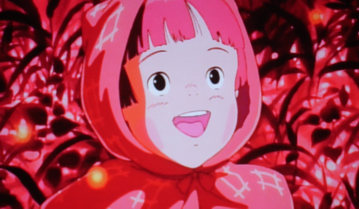 might ask, what could an animated war film possibly have to offer, let alone anime? How about a picture steeped in realism depicting the horrors of war that rivals the best of live-action, but, ironically, is hand drawn. Critics certainly are unified in their opinions. Roger Ebert added further credibility and enlightened the movie-going public when he called it one of the “greatest war films ever made.” The film is an exemplary case that Japanese anime can be taken seriously, because it transcends genre stereotypes. It’s a big picture and a strong statement that anime is not just for the Pokémon set. This is one more glowing example chipping away at the notion that animation is for children.
might ask, what could an animated war film possibly have to offer, let alone anime? How about a picture steeped in realism depicting the horrors of war that rivals the best of live-action, but, ironically, is hand drawn. Critics certainly are unified in their opinions. Roger Ebert added further credibility and enlightened the movie-going public when he called it one of the “greatest war films ever made.” The film is an exemplary case that Japanese anime can be taken seriously, because it transcends genre stereotypes. It’s a big picture and a strong statement that anime is not just for the Pokémon set. This is one more glowing example chipping away at the notion that animation is for children.
The refreshingly quiet and sobering power of Grave Of The Fireflies is reminiscent of a different era in filmmaking. You’re reminded of heart wrenching, poetic pictures of simple power focused on character struggles likes Italian Neo-Realist film The Bicycle Thief [1947] by Vittorio De Sica. It’s an important work that will stand the test of time. The film garnered the prestigious first prize Best Animated Feature Film and Rights Of The Child Awards at the 1994 Chicago International Children’s Film Festival. While rated 3 and up, this is still a distinctly influential film with disturbing images, adult themes and unsettling moments that are not for the very young. This is a film about children, the greatest casualty of war, and not necessarily one for them to see.
Grave Of The Fireflies opens with the words, “September 21, 1945, that was the night I died,” spoken by main protagonist Seita. There is no dancing around the subject matter. We are warned of the tragedy about to unfold. A gaunt, limp and lifeless Seita is literally walked around by disconnected pedestrians as he withers away alone to die from starvation. It was June 5th 1945, the southern Japanese port of Kobe was firebombed by roughly 350 B-29 American bombers utilizing incendiary, lightweight, highly combustible M-69 canister bombs [a precursor to napalm] in what were the final days of World War II. Everything would change dramatically for the civilian populace of Kobe, as it did for the ravaged innocents of Pearl Harbor, as it does for the characters in this film. Do the math and nearly three and a half months following the outcome of that event, two more casualties were left in its wake. This is the inevitability of war, the ordinary lives it touches and the damaging ripple effect it generates. The film’s message is focused and direct and striking in its powerful delivery.
Grave Of The Fireflies, not unlike most war films, is based upon truth. Like live action stories Black Hawk Down, The Great Raid or We Were Soldiers, this film achieves greatness too, in the quiet and raw truths it unveils following the fighting. Like so many of those aforementioned films it is a damning indictment of war and its effects and achieves its message without the whirr of bullets and rattle of gunfire. The strength of the
film relies not on the geo-politics of war or battle-hardened soldiers in the trenches, but on the human element of victims caught in the crossfire of war’s deadly aftermath. This story paints a portrait of suffering 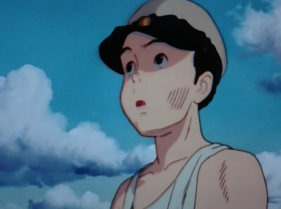 through the eyes of the innocent. It offers an alternate perspective of the war through the eyes of the Japanese, not unlike the German perspective in Das Boot. Like the aforementioned film there is no indictment of the United States. We are simply left to focus on the people war impacts, especially children. On an emotional level it shares company with the likes of The Pianist and Life Is Beautiful. These films present the immediacy and horrors of war and how it alters the normalcy of their lives and their families forever. It is a pure story that lends great weight to the old adage ‘war is hell’ indeed. It stirs emotions and feelings in the heart unlike anything you’ve seen.
through the eyes of the innocent. It offers an alternate perspective of the war through the eyes of the Japanese, not unlike the German perspective in Das Boot. Like the aforementioned film there is no indictment of the United States. We are simply left to focus on the people war impacts, especially children. On an emotional level it shares company with the likes of The Pianist and Life Is Beautiful. These films present the immediacy and horrors of war and how it alters the normalcy of their lives and their families forever. It is a pure story that lends great weight to the old adage ‘war is hell’ indeed. It stirs emotions and feelings in the heart unlike anything you’ve seen.
Grave Of The Fireflies presents the American attacks on Japanese soil, but again it is not an anti-American film at its core. In fact, Director Isao Takahata commented on GhibliWorld.com during an interview at Anima 2006, “I completely disagree with people… that claim that Japan had no other option than to go to war. It was no reaction to something that happened, but Japan’s own choice to attack other Asian countries and also the war with America was a result of this wrong choice.” The film certainly serves as one of the most potent anti-war depictions ever to grace film, though unintentional and more as a by-product of the real tale Takahata prefers to tell. The script, by Director/Writer Isao Takahata, is based upon a true story by respected Japanese author Akiyuki Nosaka. He spoke semi-autobiographically of the malnutrition of his own sister and his experiences throughout the war as recounted in his own book of the same name, Hotaru no Haka. The account had been bestowed the honorable Naoki Prize For Literature award [Japan’s equivalent to the Pulitzer Prize] in 1968, as selected by The Society For The Promotion of Japanese Literature, and became an integral part of Japanese studies. Nosaka’s novel made no bones about the fact that the essence of the script was based upon what was clearly a “double-suicide story.” Despite that fact, rarely has a film presented human anguish so vividly. Grave Of The Fireflies is a commanding case in point to the grim realities of war on a deeply personal level.
Grave Of The Fireflies is heartbreaking. It tells one of the most touching tales of love and survival and inevitably death. Soft-spoken director Takahata put it succinctly on the DVD extras; “the main characters die you know- it’s hard to get films like that made.” It makes no apologies in presenting the tragic fate of its two gentle protagonists. We are subjected to a deeply personal, intimate film witnessed through the eyes of its
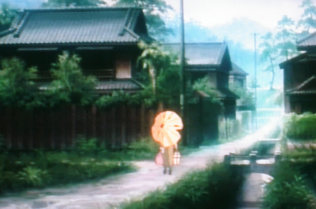 lead sibling characters. Seita narrates as the strong-willed, sometimes stubborn, comforting, older brother to the trusting sweetness of Setsuko. It is a story not just about dying, but about the choices we make in living, right or wrong, in handling severe adversity and dire circumstances. We are led down the path knowing the conclusion, but the creators allow us to fall in love with these children and we cannot turn away. We respond to their joys and their hurt. Seita does everything he feels within his power to shield his sister from the encroaching nightmare of hunger and the images of war that surround them. Despite the hardships, he holds his sister dear to him. She is his hope for the future. He seeks to preserve Setsuko’s childhood innocence. Yet, ironically, in shielding and protecting her, he builds a wall and is incapable and too proud to ask for help. Author Akiyuki Nosaka said it best in Animerica [1994] [originally taken from Animage 1987], “for Seita, it’s like he can try to build a heaven for just the two of them.” Seita and Setsuko are equally co-dependent on one another in their world of survival. Where there is no food, they nourish one another. Nosaka explains “she is overwhelmingly dependent on him, but she also becomes his spiritual support.”
lead sibling characters. Seita narrates as the strong-willed, sometimes stubborn, comforting, older brother to the trusting sweetness of Setsuko. It is a story not just about dying, but about the choices we make in living, right or wrong, in handling severe adversity and dire circumstances. We are led down the path knowing the conclusion, but the creators allow us to fall in love with these children and we cannot turn away. We respond to their joys and their hurt. Seita does everything he feels within his power to shield his sister from the encroaching nightmare of hunger and the images of war that surround them. Despite the hardships, he holds his sister dear to him. She is his hope for the future. He seeks to preserve Setsuko’s childhood innocence. Yet, ironically, in shielding and protecting her, he builds a wall and is incapable and too proud to ask for help. Author Akiyuki Nosaka said it best in Animerica [1994] [originally taken from Animage 1987], “for Seita, it’s like he can try to build a heaven for just the two of them.” Seita and Setsuko are equally co-dependent on one another in their world of survival. Where there is no food, they nourish one another. Nosaka explains “she is overwhelmingly dependent on him, but she also becomes his spiritual support.”
The story unfolds in two sections for Seita and Setsuko. The first half follows on from the loss of their mother during an allied raid while their father is at war. There is a great deal going on behind the burdened eyes of Seita. Their uprooted, tumultuous lives lead to the obligatory care of their unsympathetic aunt. She shows them a cold, cold heart barely fazed that Seita and Setsuko have just lost their mother and might be emotionally troubled. It is a difficult time and food is scarce. Instead of loving arms and open hearts, they receive begrudging support. Never mind the disregard of strangers, as the children’s own family turns its back on them. Imagine being unwanted by your own flesh and blood over and above a detached community. The aunt torments the two kids emotionally through verbal abuse eventually driving them away. “You keep saying you want rice, but do you do anything to earn it? You two are nothing but trouble for me.” Seita’s wounded pride forces him to go it alone with his sister in the countryside where he can love her unmolested by their aunt. The second half of the film takes place there.
There are joyful moments as Seita looks to the future, “when it gets a little warmer, I’ll teach you how to swim.” The glow of the fireflies at night lights their souls. It’s not long before Setsuko is burying them in the
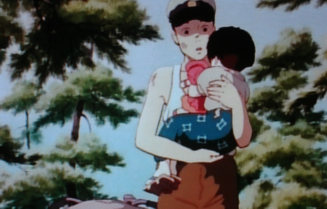 dirt, tragically symbolic of their own short lives. When the light fades and fireflies die, so slowly does the spark burning inside Setsuko and Seita. He later learns his aunt insensitively told Setusko of her mother’s death much against Seita’s wishes. In one of the most excruciating moments, Seita cries over the cruelties bestowed upon his sister and his inability to preserve her physical and mental health. It becomes an increasingly delusional place to be for Seita. Their well being slowly unravels [diarrhea, scabs, bug bites, malnutrition] deteriorating beyond his control in their makeshift home [an air raid/ bomb shelter built into the hillside]. Ironically, their safe house would become their grave. Even as he fails Setsuko, one man tells Seita “swallow your pride and apologize” to his aunt, but Seita’s personal dignity will not allow him to go back. The demands placed on Seita to bear the burden of parent are too great. He goes to great odds to keep his sister alive risking his own life day after day, stubbornly opting not to go back. Is it hubris that fuels him? Over-confidence is the very definition of Greek tragedy that flaws Seita’s drive. In the end, he must cremate his own sister for God’s sake. If this isn’t brutal, agonizing stuff I don’t know what is.
dirt, tragically symbolic of their own short lives. When the light fades and fireflies die, so slowly does the spark burning inside Setsuko and Seita. He later learns his aunt insensitively told Setusko of her mother’s death much against Seita’s wishes. In one of the most excruciating moments, Seita cries over the cruelties bestowed upon his sister and his inability to preserve her physical and mental health. It becomes an increasingly delusional place to be for Seita. Their well being slowly unravels [diarrhea, scabs, bug bites, malnutrition] deteriorating beyond his control in their makeshift home [an air raid/ bomb shelter built into the hillside]. Ironically, their safe house would become their grave. Even as he fails Setsuko, one man tells Seita “swallow your pride and apologize” to his aunt, but Seita’s personal dignity will not allow him to go back. The demands placed on Seita to bear the burden of parent are too great. He goes to great odds to keep his sister alive risking his own life day after day, stubbornly opting not to go back. Is it hubris that fuels him? Over-confidence is the very definition of Greek tragedy that flaws Seita’s drive. In the end, he must cremate his own sister for God’s sake. If this isn’t brutal, agonizing stuff I don’t know what is.
The film is heavily autobiographical on Nosaka’s life and wartime experience with his young sister, which explains why we so easily empathize with the characters’ desperate reality. We easily identify with this very real, very strong material. “My only support back then was my two-year-old sister. If I was stealing, I could feel it was justified if it was for my sister. That I was doing bad things in the process of growing up; was all compensated for by the existence of my sister.” The power is in the details of the film’s truths and characterizations taken from Nosaka’s own life lessons. Director Isao Takahata and animator Yoshifumi Kondo do his book great justice with a remarkable translation of the work. Life didn’t quite imitate art, as Nosaka survived while his sister would not, and something inside him died with her that day. Nosaka himself had to find a way to adapt and live with guilt. Interestingly, Nosaka indicated the despair for him over his young sibling was much greater than even he could write about in his book and in turn it has been left out of the picture. “I was trying to compensate for everything I couldn’t do myself. I was never kind like the main character. I always thought I wanted to perform those generous acts in my head, but couldn’t do so. I’d think there was no one more hopeless in the world than me. I didn’t put anything about this in the novel.” What Takahata is able to convey in the film amidst the sadness, is the beauty of simple joys between these two children who share nothing but love for one another. Takahata may take artistic liberties in interpreting Nosaka’s portrayal of their relationship, but that is the beauty of film in sometimes romanticizing the most horrific of circumstances. He pays great tribute in forgiving Nosaka’s dreadful reality as a human being, and remains true to the substance of his story, while injecting his own memories of those events.
The devastating subject matter aside, Grave Of The Fireflies, is a beautifully animated film that enhances the emotional impact of the film. This is a picture filled, not with imaginary geo-fronts and alternate Tokyo realities found in much of anime, but with real locations and Japanese landscapes. Some scenes appear like watercolor paintings come to life through picturesque greens and blues or fiery reds and browns. The distinctly Japanese film captures a period portrait of the island nation in muted, but lovingly animated color. When the time came to make his story into a film, Nosaka told Animerica he was thrilled it would be animated because he could not envision it as a live film. “From the rice paddies in the background to the townscape - that wouldn’t be possible filming at some location. I’ve looked for a photo of that place from that
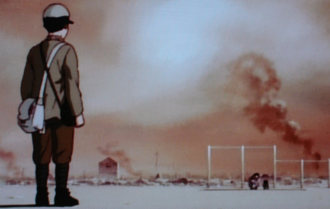 time period, but I’ve yet to find it.” Director Isao Takahata received Nosaka’s full blessing along with Studio Ghibli’s head Hayao Miyazaki who urged him to direct the film. Director Takahata elaborated on this often slippery slope in anime in Animerica. “I haven’t depicted ‘Japan’ before. That’s because in Japanese animation, you’re not allowed to depict Japan with much realism. We can research a lot about foreign countries though. But that hasn’t been done for a Japanese story.” To highlight the reality of life in a post-World War II Japan, the film utilized the color brown overwhelmingly in favor of softening the film and its characters over the striking tone of black used in most traditional animation. Colorist Michiya Hoda told Animerica “it was a technique unused in anime up until that point.” The talent of Japan’s finest artists doesn’t detract from what is an expertly written and often disturbing screenplay. Director of Photography Nobuo Koyama plays a significant part in the atmosphere of this film’s cinematic quality. Future Gainax mastermind Hideaki Anno also played a key role in animating the production. The sweeping score, the rich character development and the detail of the animation all lends itself to an amazing portrait of life in Japan circa 1945. The exquisite animation may have a little something to do with a shop called Studio Ghibli. Co-founder and chief Animation Director of the studio, Yoshifumi Kondo, played a significant role in the making of three other notable anime classics in Porco Rosso, Kiki’s Delivery Service and the epic Princess Mononoke under the direction of the much heralded and respected anime master, Hayao Miyazaki, before striking out to create his own masterstroke. This is a visually stirring picture and the director utilized each cel purposefully through its 88-minute runtime. There is nothing gratuitous or pointless about a single frame in this visual elegy.
time period, but I’ve yet to find it.” Director Isao Takahata received Nosaka’s full blessing along with Studio Ghibli’s head Hayao Miyazaki who urged him to direct the film. Director Takahata elaborated on this often slippery slope in anime in Animerica. “I haven’t depicted ‘Japan’ before. That’s because in Japanese animation, you’re not allowed to depict Japan with much realism. We can research a lot about foreign countries though. But that hasn’t been done for a Japanese story.” To highlight the reality of life in a post-World War II Japan, the film utilized the color brown overwhelmingly in favor of softening the film and its characters over the striking tone of black used in most traditional animation. Colorist Michiya Hoda told Animerica “it was a technique unused in anime up until that point.” The talent of Japan’s finest artists doesn’t detract from what is an expertly written and often disturbing screenplay. Director of Photography Nobuo Koyama plays a significant part in the atmosphere of this film’s cinematic quality. Future Gainax mastermind Hideaki Anno also played a key role in animating the production. The sweeping score, the rich character development and the detail of the animation all lends itself to an amazing portrait of life in Japan circa 1945. The exquisite animation may have a little something to do with a shop called Studio Ghibli. Co-founder and chief Animation Director of the studio, Yoshifumi Kondo, played a significant role in the making of three other notable anime classics in Porco Rosso, Kiki’s Delivery Service and the epic Princess Mononoke under the direction of the much heralded and respected anime master, Hayao Miyazaki, before striking out to create his own masterstroke. This is a visually stirring picture and the director utilized each cel purposefully through its 88-minute runtime. There is nothing gratuitous or pointless about a single frame in this visual elegy.
The gentle, understated musical score offers just the right complement to the picture’s tone. The music, like the film, is pensive, quiet allowing the themes to fill our minds in a more thought-provoking way than most war movies. Central Park Media provides a warm and moving English dub for the US release that does not detract from the content of the artsists’ original vision. Central Park Media digitally restored and remastered the film with digital video noise reduction and offered otaku a lovingly packaged 2 DVD tribute to this story of two lives forever lost in the balance. Director Isao Takahata speaks in detail about working with his voice actors and actresses. He talks about the difficulty of releasing it as a double bill with My Neighbor Tortoro. He talks at length about the character Seita and how audiences missed some of what he was attempting to convey about his impatience and how living like him could mean death. He candidly touches on his own experience during World War II and the firebombing that occurred when he was just ten years old. He is clearly a man changed by his past, which he depicts with genuine feeling in the film. Roger Ebert, too, offers an exceptional interview complete with a variety of details on the anime genre. Film buffs will enjoy his discussion of “pillow shots” in Japanese film that allow a viewer to absorb the moments and artfully express even weighty material such as this. Grave Of The Fireflies is filled with these shots [backyards, alleys, buckets], which vividly paint a cultural portrait of life in the day.
Grave Of The Fireflies is pure human tragedy. You have Seita’s hopes combined with Setsuko’s simple joys in the face of an impending fate. Takahata noted in an interview with GhibliWorld.com, “in the end it’s not all good, but … it is necessary to have hope.” These are children who are victims to the loss of a mother and father, victims to the heartless isolation from extended family and victims of homelessness and starvation
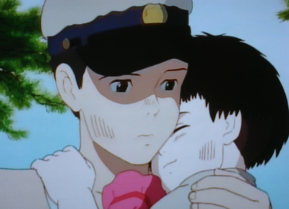 in a devastated society. These are the lonely victims of war. It is uncommon to see such unflinching honesty and brutality portrayed in such personal, intimate detail. Despite hunger and indifference by their own people, Takahata illustrates unconditional love between the orphaned brother and sister. It is a credit to the director’s gifts to bring such a picture to fruition focusing on the fragility of life at a time of war. It is the rare kind of war film everyone should see, because it teaches you something about humanity. It makes you think about choices and consequences. Why are these characters so paralyzed in a time of crisis? Why are people so unwilling to help? What lengths will these children go to survive? How could things have been different? It is an example of how our own personal fortunes are dependent on very specific circumstances and variables in our lives. You’re left questioning your own existence. How would you respond? It’s not an easy film with easy solutions. It is often excruciating and there is no happy Hollywood ending. It is a parable reflecting the ramifications of war and how it cripples lives. This is the unbearable suffering of two innocents and the luminous, firefly-like spirit of their genuine love for one another. Setsuko inquires, “Why do fireflies die so young?” Grave Of The Fireflies is often harrowing and will have you asking the very same question. This is a difficult film to witness, but few combine the pain, joy and beauty of living so seamlessly in the face of darkness and despair as this film does. There are truths to dig from this grave and come away with after watching it. I like to think it’s about finding love in the most unlikely of places. This is a rare work indeed. It is pure, simple, honest filmmaking that will sear your memory forever. It is profoundly moving, and dare I say, the most emotional war film ever made period. This is one you’ll want to share with anyone who will listen. It’s also some of the most beautiful, timeless animation you will ever see and despite your tears and what you might have heard - you will watch it again.
in a devastated society. These are the lonely victims of war. It is uncommon to see such unflinching honesty and brutality portrayed in such personal, intimate detail. Despite hunger and indifference by their own people, Takahata illustrates unconditional love between the orphaned brother and sister. It is a credit to the director’s gifts to bring such a picture to fruition focusing on the fragility of life at a time of war. It is the rare kind of war film everyone should see, because it teaches you something about humanity. It makes you think about choices and consequences. Why are these characters so paralyzed in a time of crisis? Why are people so unwilling to help? What lengths will these children go to survive? How could things have been different? It is an example of how our own personal fortunes are dependent on very specific circumstances and variables in our lives. You’re left questioning your own existence. How would you respond? It’s not an easy film with easy solutions. It is often excruciating and there is no happy Hollywood ending. It is a parable reflecting the ramifications of war and how it cripples lives. This is the unbearable suffering of two innocents and the luminous, firefly-like spirit of their genuine love for one another. Setsuko inquires, “Why do fireflies die so young?” Grave Of The Fireflies is often harrowing and will have you asking the very same question. This is a difficult film to witness, but few combine the pain, joy and beauty of living so seamlessly in the face of darkness and despair as this film does. There are truths to dig from this grave and come away with after watching it. I like to think it’s about finding love in the most unlikely of places. This is a rare work indeed. It is pure, simple, honest filmmaking that will sear your memory forever. It is profoundly moving, and dare I say, the most emotional war film ever made period. This is one you’ll want to share with anyone who will listen. It’s also some of the most beautiful, timeless animation you will ever see and despite your tears and what you might have heard - you will watch it again.
Remember, if you’re short on tissues, toilet paper will do just fine...

